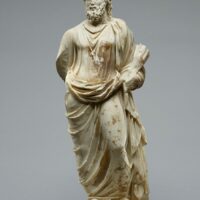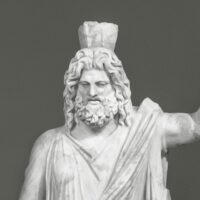Pluto : God of the Underworld
Listen
At a glance
| Description | |
|---|---|
| Origin | Roman Mythology |
| Classification | Gods |
| Family Members | Saturn (Father), Ops (Mother), Jupiter, Neptune (Brother), Proserpina (Wife) |
| Region | Italy |
| Associated With | Underworld |
Pluto
Introduction
In Roman mythology, Pluto is a key deity renowned as the god of the underworld. He governs the realm of the dead with an aura of authority and enigma, setting him apart from other gods. While his Greek equivalent, Hades, shares many traits, Pluto’s Roman identity is distinct, reflecting unique attributes and cultural significance. Unlike the more flamboyant Olympian gods, Pluto oversees an unseen dominion where souls reside, embodying both the essence of death and the afterlife. Known also as Dis Pater or Orcus, Pluto is a central figure among Roman chthonic deities, ruling over the subterranean realms and symbolizing both fear and wealth.
Physical Traits
Pluto resided in a gloomy palace deep underground, where his presence was marked by a formidable appearance. Often depicted as a mature man with a dark, somber expression, he is characterized by his austere and commanding demeanor. Artists usually show him in dark robes, emphasizing the shadowy nature of his realm, and occasionally with a warrior’s helm. Accompanying him is Cerberus, his three-headed guard dog, symbolizing his role as both the ruler and protector of the underworld.
Unlike the more idealized Olympian gods, Pluto’s depictions focus on his stoic and serious nature. His beard, frequently streaked with grey, highlights his wisdom and experience. He is rarely shown smiling, reinforcing the somber tone of his domain. Pluto is often portrayed holding a scepter, a symbol of his authority, which may be adorned with the key of Orcus—a mythical key that signifies his control over the gates of the underworld.
Family
Pluto’s heritage is intricately linked with the broader narratives of Roman mythology. He is the offspring of Saturn, the Titan king, and Ops, the goddess of fertility. Following the Titans’ defeat by the Olympians, Pluto and his brothers—Jupiter (Zeus) and Neptune (Poseidon)—each took control of different realms, with Pluto inheriting the underworld through a division of domains. This lineage ties him to key cosmic forces, with his familial connections placing him in the divine hierarchy.
His consort, Proserpina (known as Persephone in Greek mythology), is the daughter of Jupiter and Ceres (Demeter). Pluto’s abduction of Proserpina and her subsequent role as queen of the underworld are central to the myth explaining the seasons. Her presence on earth signifies spring and summer, while her return to the underworld heralds autumn and winter. This mythological backdrop underscores Pluto’s pivotal role in both the celestial and seasonal cycles.
Other names
Pluto’s name, derived from the Greek “Plouton,” translates to “the wealthy one,” underscoring his dominion over underground riches. Early Romans also revered him as Dīs Pater, a title that evolved from its original association with Jupiter and later merged with the Greek deity Hades. This title reflects his role as a ruler of hidden treasures.
Roman tradition assigned Pluto several other names to reflect different aspects of his authority. “Dis Pater” signifies his role as the patriarch of the underworld, while “Orcus” highlights his function in administering justice, influenced by the Etruscan god of the underworld. “Summanus” connects him to chthonic deities, and “Infernus,” meaning “the god below,” directly references his dominion over the underworld. These names collectively illustrate the diverse facets of Pluto’s role and responsibilities.
Powers and Abilities
As ruler of the underworld, Pluto wields considerable powers that evoke both awe and fear. His absolute authority enables him to dictate the destinies of souls, enforce punishments, and maintain order in the realm of the dead. He also has the ability to communicate with and control the spirits, ensuring a balanced management of the underworld.
Pluto’s dominion extends to the riches hidden beneath the earth, including precious metals and gems, reinforcing his role as the god of wealth. He is often depicted wielding the “Cypress Staff” or “Scepter of the Underworld,” which symbolizes his command over the realm and its inhabitants. Additionally, Pluto possesses the “Helm of Darkness,” allowing him to become invisible and move undetected among gods and mortals, further amplifying his enigmatic influence.
Modern Day Influence
Pluto’s impact extends into modern culture across multiple fields, including literature, art, and astronomy. In literature, Pluto often embodies themes of death and the afterlife, shaping narratives from classical works to contemporary fiction. His portrayal reflects both his fearsome role as a ruler and his complex aspects of justice and life’s cyclical nature.
Artistic representations of Pluto emphasize his regal and imposing character, appearing in paintings, sculptures, and other media. His symbolism extends to popular culture, where he represents concepts of the underworld and death. In astronomy, the discovery of the planet Pluto in 1930 led to its naming after the Roman god, reflecting its distant and mysterious qualities. Despite its reclassification as a dwarf planet in 2018, Pluto’s name endures, maintaining its connection to the mythological figure and his realm. The god of the underworld also influences modern entertainment, with adaptations of his mythological persona appearing in movies, TV shows, and video games, showcasing his lasting cultural significance.
Related Images
Frequently Asked Questions
What is lorem Ipsum?
I am text block. Click edit button to change this text. Lorem ipsum dolor sit amet, consectetur adipiscing elit. Ut elit tellus, luctus nec ullamcorper mattis, pulvinar dapibus leo.
What is lorem Ipsum?
I am text block. Click edit button to change this text. Lorem ipsum dolor sit amet, consectetur adipiscing elit. Ut elit tellus, luctus nec ullamcorper mattis, pulvinar dapibus leo.
What is lorem Ipsum?
I am text block. Click edit button to change this text. Lorem ipsum dolor sit amet, consectetur adipiscing elit. Ut elit tellus, luctus nec ullamcorper mattis, pulvinar dapibus leo.
What is lorem Ipsum?
I am text block. Click edit button to change this text. Lorem ipsum dolor sit amet, consectetur adipiscing elit. Ut elit tellus, luctus nec ullamcorper mattis, pulvinar dapibus leo.
What is lorem Ipsum?
I am text block. Click edit button to change this text. Lorem ipsum dolor sit amet, consectetur adipiscing elit. Ut elit tellus, luctus nec ullamcorper mattis, pulvinar dapibus leo.












